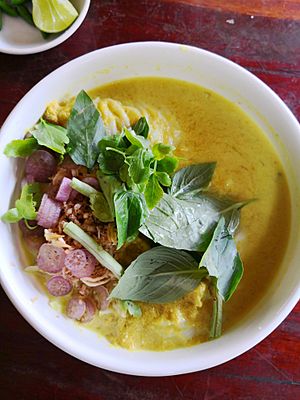Num banhchok facts for kids
 |
|
| Alternative names | Num Banh Chok, Cambodian rice noodles, Khmer noodles, nom panchok, nom pachok, noum bahnchok, num panchok, num pachok |
|---|---|
| Course | Breakfast or sometimes lunch |
| Place of origin | Cambodia |
| Region or state | Southeast Asia |
| Associated national cuisine | Cambodia |
| Serving temperature | Warm to room temperature |
| Main ingredients | Lightly-fermented rice noodles, yellow kroeung, prahok, freshwater fish, coconut milk/coconut cream, bean sprouts, cucumber, water lily stems, and wing beans |
| Variations | num banhchok samlar kari, num banhchok namya, num banhchok Kampot, num banhchok tuek mrech, num banhchok samla yuon, num banhchok sras |
| Similar dishes | mohinga, khanom chin, mixian |
Num banhchok (Khmer: នំបញ្ចុក, num bânhchŏk) is a very popular breakfast dish in Cambodia. It's made with special rice noodles that are slightly fermented. People in Cambodia love to eat num banhchok to start their day.
This tasty dish is known by many names, like Khmer noodles or Cambodian rice noodles. You can find different versions of num banhchok all over Cambodia, each with its own unique flavor. It's often served warm and is a big part of Cambodian food culture.
How is Num Banhchok Made?
Making num banhchok noodles takes a few steps. First, rice is soaked in water for about 2 to 4 hours. This makes the rice soft enough to be ground into a smooth, liquidy paste.
Next, this rice paste is pressed into round shapes. These shapes are then dried inside special cotton bags called calico bags. Once dry, the rice is crushed into a powder. This powder is then mixed with water to create a thick, sticky paste.
Finally, this thick paste is pushed through a special tool that shapes it into long, thin noodles. These noodles drop right into boiling water. They cook quickly, usually in 3 to 4 minutes. After cooking, the noodles are moved to cold water to stop them from cooking further. This process makes the fresh, soft noodles ready to be served with delicious sauces and vegetables.
The Story of Num Banhchok
Num banhchok is not just food; it's also part of a famous Khmer folk legend. This story is about a clever scholar named Thonchey.
The legend says that Thonchey was sent away to China by the Khmer king. To earn a living in China, Thonchey started making num banhchok. His noodles became very popular with the Chinese people.
The fame of his dish even reached the Chinese emperor. The emperor asked Thonchey to bring num banhchok to his palace. When Thonchey arrived, he managed to see the emperor's face while the emperor was tasting the dish. Thonchey then said something that insulted the emperor, and he was immediately put in jail.
However, Thonchey was very smart and soon found a way to get released. He then returned to the Khmer Empire. This story shows how important num banhchok was, even in ancient times.


